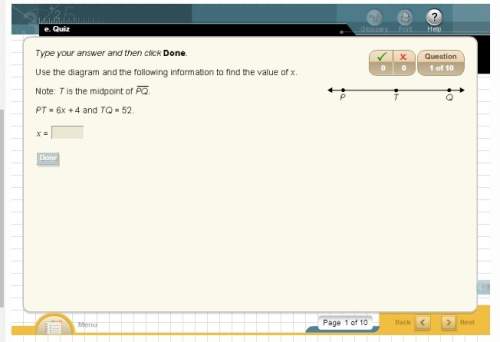
Mathematics, 19.07.2019 17:30 ItsNataly101
The graph of the continuous function g, the derivative of the function f, is shown above. the function g is piecewise linear for -5 ≤ x < 3 and g(x) = 2(x-4)^2 for 3 ≤ x ≤ 6. (a) if f(1) = 3, what is the value of f(-5) ? (b) evaluate \; dx) . (c) for -5 < x < 6, on what open intervals, if any, is the graph of f both increasing and concave up? give a reason for your answer. (d) find the x-coordinate of each point of inflection of the graph of f. give a reason for your answer. (this was on the no-calculator section of the recently-released ap calculus ab 2018 exam so i appreciate it if you tried to limit calculator usage)
. (c) for -5 < x < 6, on what open intervals, if any, is the graph of f both increasing and concave up? give a reason for your answer. (d) find the x-coordinate of each point of inflection of the graph of f. give a reason for your answer. (this was on the no-calculator section of the recently-released ap calculus ab 2018 exam so i appreciate it if you tried to limit calculator usage)

Answers: 1


Another question on Mathematics

Mathematics, 21.06.2019 19:00
Quadrilateral abcd in the figure below represents a scaled-down model of a walkway around a historic site. quadrilateral efgh represents the actual walkway. abcd is similar to efgh. what is the total length, in feet of the actual walkway?
Answers: 2

Mathematics, 21.06.2019 23:20
The graph of y=x3 is transformed as shown in the graph below. which equation represents the transformed function?
Answers: 1

Mathematics, 22.06.2019 01:00
What is the y-intercept of the line with the equation 3x + 4y = 12?
Answers: 1

Mathematics, 22.06.2019 02:30
Ineed on these fraction questions! could'ya me? 1. 3/8 ( ? ) 0.295 a. = b. > c. < 2. -0.770 ( ? ) -4/5 a. = b . < c. >
Answers: 1
You know the right answer?
The graph of the continuous function g, the derivative of the function f, is shown above. the functi...
Questions

Biology, 13.04.2021 19:00

Mathematics, 13.04.2021 19:00

Engineering, 13.04.2021 19:00


Chemistry, 13.04.2021 19:00


Physics, 13.04.2021 19:00

English, 13.04.2021 19:00

Mathematics, 13.04.2021 19:00

Spanish, 13.04.2021 19:00

Mathematics, 13.04.2021 19:00


Chemistry, 13.04.2021 19:00

Mathematics, 13.04.2021 19:00



English, 13.04.2021 19:00



Mathematics, 13.04.2021 19:00

 is continuous, so
is continuous, so  is also continuous. This means if we were to integrate
is also continuous. This means if we were to integrate  , the same constant of integration would apply across its entire domain. Over
, the same constant of integration would apply across its entire domain. Over  , we have
, we have  . This means that
. This means that
 to match
to match  . This means we must have
. This means we must have
 , we have
, we have  , so
, so  , which means
, which means  .
.
 , and concave upward when
, and concave upward when  , i.e. when
, i.e. when  over the intervals
over the intervals  and
and  . We can additionally see that
. We can additionally see that  only on
only on  , and at such a point, to either side the sign of the second derivative
, and at such a point, to either side the sign of the second derivative  changes. We see this happening at
changes. We see this happening at  , for which
, for which  , and to the left of
, and to the left of  , but even if we were to allow an entire interval as a "site of inflection", we can see that
, but even if we were to allow an entire interval as a "site of inflection", we can see that 


